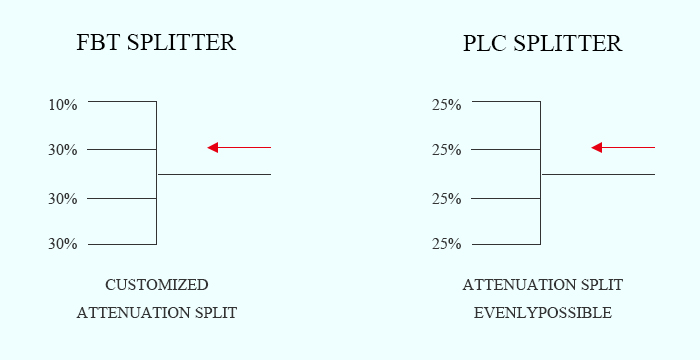FBT Splitter vs. PLC Splitter: What Are the Differences?
Fiber optic splitter is a passive optical device that can split or separate an incident light beam into two or more light beams. Basically, there are two types of optical fiber splitter classified by their working principle: FBT splitter (fused biconical taper splitter) and PLC splitter (planar lightwave circuit splitter). There are lots of differences between FBT splitter and PLC splitter, which is confusing for many users. This tutorial will walk you through the main ones between them.
What Is PLC Splitter?
PLC splitter is based on planar lightwave circuit technology. It comprises three layers: a substrate, a waveguide, and a lid. The waveguide plays a key role in the splitting process which allows for passing specific percentages of light. So the signal can be split equally. In addition, PLC splitters are available in a variety of split ratios, including 1:4, 1:8, 1:16, 1:32, 1:64, etc. They also have several types, such as bare PLC splitter, blockless PLC splitter, fanout PLC splitter, mini plug-in type PLC splitter, etc. You also can check the article How Much Do You Know About PLC Splitter? for more information about PLC splitter. The following table shows the advantages and disadvantages of PLC splitter.
| Advantages | Disadvantages |
|---|---|
|
|
What Is FBT Splitter?
FBT splitter is based on traditional technology, involving the fusion of several fibers from the side of each fiber. The fibers are aligned by heating them at a specific location and length. Due to the fragility of the fused fibers, they are protected by a glass tube made of epoxy and silica powder. Subsequently, a stainless steel tube covers the inner glass tube and is sealed with silicon. As technology continues to develop, the quality of FBT splitters has significantly improved, making them a cost-effective solution. The following table outlines the advantages and disadvantages of FBT splitters
| Advantages | Disadvantages |
|---|---|
|
|
FBT Splitter vs PLC Splitter: What Are the Differences?
1. Operating Wavelength
FBT splitter only supports three wavelengths: 850nm, 1310nm, and 1550nm, which makes its inability to work on other wavelengths. The PLC splitter can support wavelengths from 1260 to 1650nm. The adjustable range of wavelength makes PLC splitter suitable for more applications.

Figure1: Operating Wavelength Comparision
2. Splitting Ratio
Splitting ratio is decided by the inputs and outputs of an optical cable splitter. The maximum split ratio of FBT splitter is up to 1:32, which means one or two inputs can be split into an output maximum of 32 fibers at a time. However, the split ratio of PLC splitter is up to 1:64 - one or two inputs with an output maximum of 64 fibers. Besides, FBT splitter is customizable, and the special types are 1:3, 1:7, 1:11, etc. But PLC splitter is non-customizable, and it has only standard versions like 1:2, 1:4, 1:8, 1:16, 1:32, and so on.

Figure2: Splitting Ratio Comparision
3. Splitting Uniformity
The signal processed by FBT splitters cannot be split evenly due to a lack of management of the signals, so its transmission distance can be affected. However, PLC splitter can support equal splitter ratios for all branches, which can ensure a more stable optical transmission.

Figure3: Splitting Uniformity Comparision
4. Failure Rate
FBT splitter is typically used for networks requiring the splitter configuration of less than 4 splits. The larger the split, the greater the failure rate. When its splitting ratio is larger than 1:8, more errors will occur and cause a higher failure rate. Thus, FBT splitter is more restricted to the number of splits in one coupling. But the failure rate of PLC splitter is much smaller.

Figure4: Failure Rate Comparision
5. Temperature-Dependent Loss
In certain areas, the temperature can be a crucial factor that affects the insertion loss of optical components. FBT splitter can work stable under the temperature of -5 to 75℃. PLC splitter can work at a wider temperature range of -40 to 85 ℃, providing relatively good performance in the areas of extreme climate.
6. Price
Owing to the complicated manufacturing technology of PLC splitter, its cost is generally higher than the FBT splitter. If your application is simple and short of funds, FBT splitter can provides a cost-effective solution. Nevertheless, the price gap between the two splitter types is narrowing as the demand for PLC splitters continues to rise.
7. Size
FBT splitters typically have a larger and bulkier design compared to PLC splitters. They demand more space and are better suited for applications where size is not a limiting factor. PLC splitters boast a compact form factor, making them easily integrable into small packages. They excel in applications with limited space, including inside patch panels or optical network terminals.
Conclusion
Although the outer appearance and size of FBT and PLC fiber splitter seem rather similar, their internal technologies and specifications differ in various ways. Over the past few years, splitter technology has made a huge step forward in the past few years by introducing PLC splitter. It has proven itself as a higher reliable type of device compared to the traditional FBT splitter. If high split counts, small package size, and low insertion loss are required, you are suggested to choose PLC splitter rather than FBT splitter.
You might be interested in
Email Address

-
PoE vs PoE+ vs PoE++ Switch: How to Choose?
Mar 16, 2023















